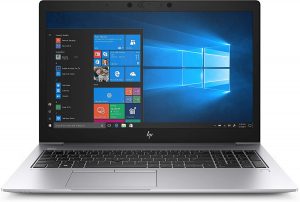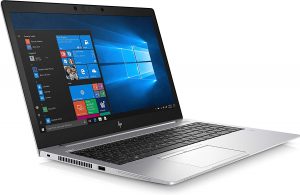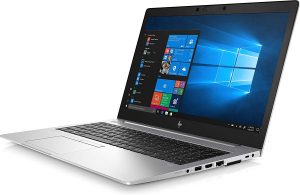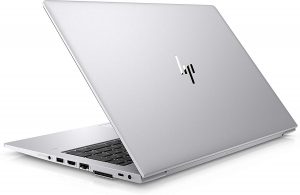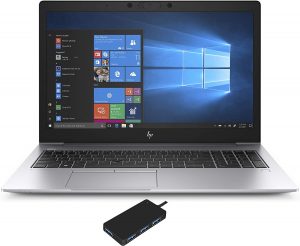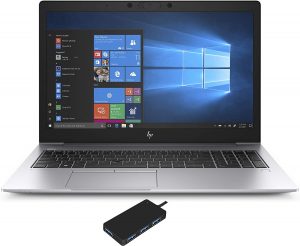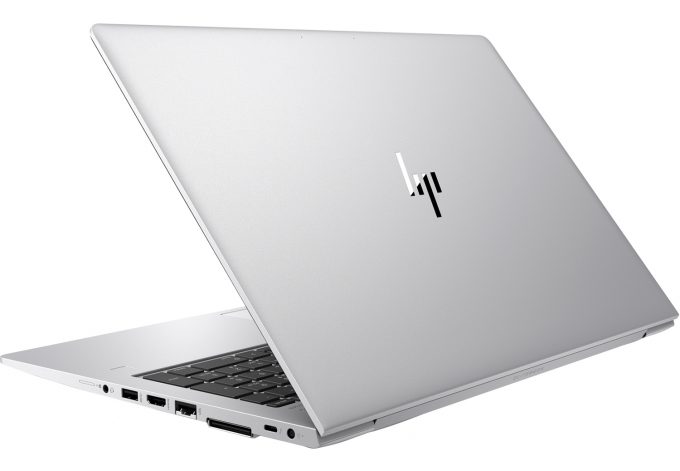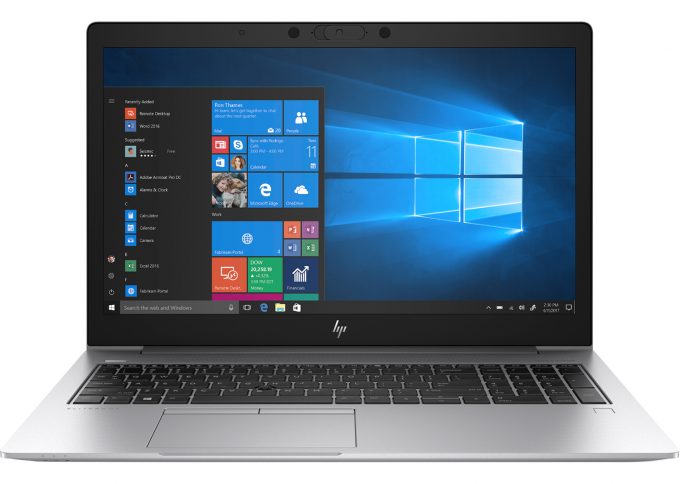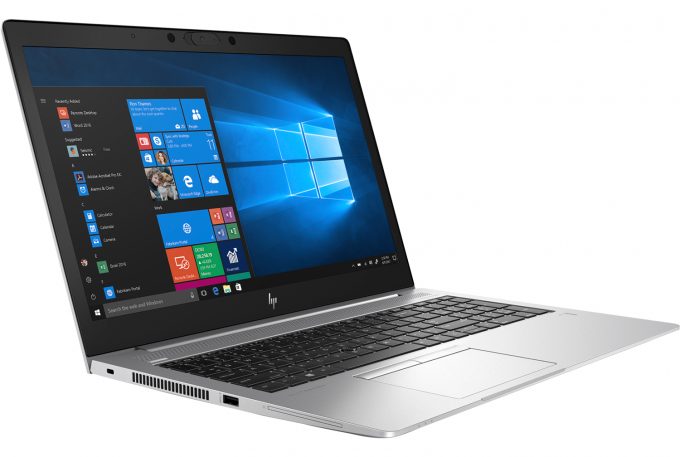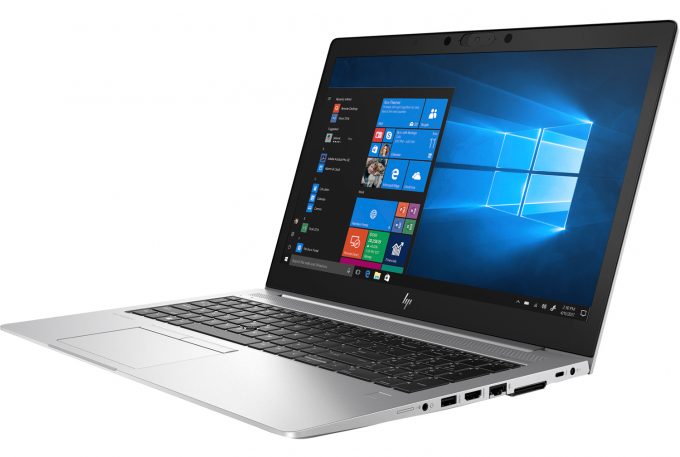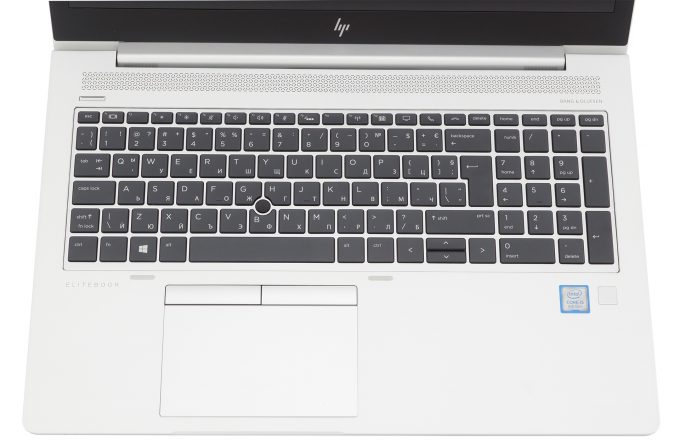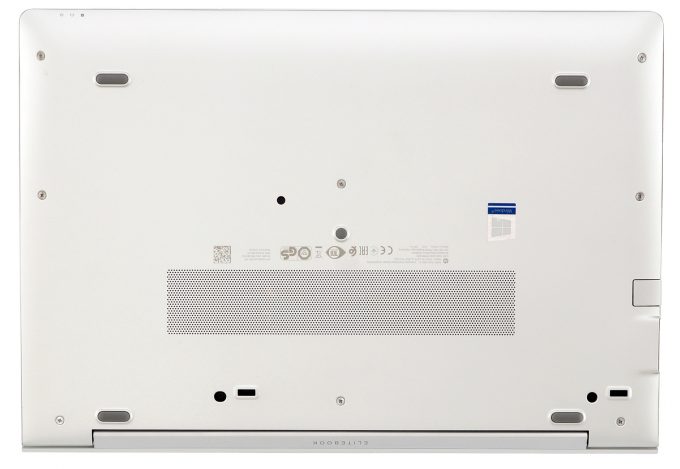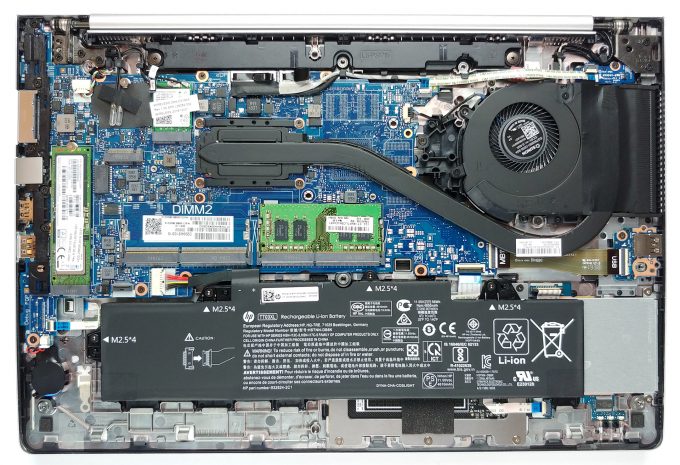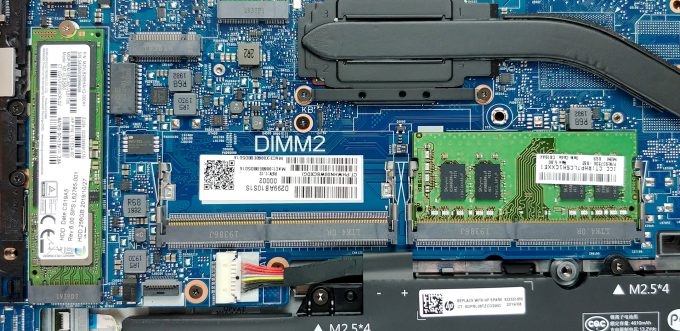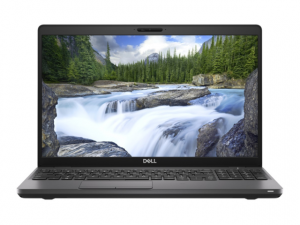HP EliteBook 850 G6 review – little changes – big improvements
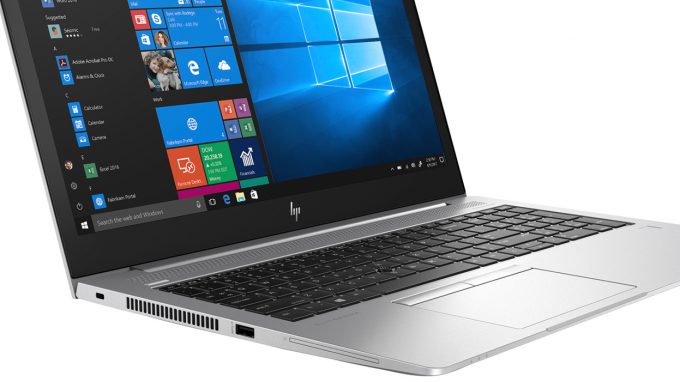 While some manufacturers are introducing big redesigns on their premium business notebook series, HP is only doing a minor refresh. What does that include? Well, they have included the Whiskey Lake CPU line-up from last year over the Kaby Lake R, which honestly is the slightest of updates. However, the device can now be paired with an AMD Radeon RX 550 and is fitted with up to a 4K IPS display for those, who really need the extra sharpness.
While some manufacturers are introducing big redesigns on their premium business notebook series, HP is only doing a minor refresh. What does that include? Well, they have included the Whiskey Lake CPU line-up from last year over the Kaby Lake R, which honestly is the slightest of updates. However, the device can now be paired with an AMD Radeon RX 550 and is fitted with up to a 4K IPS display for those, who really need the extra sharpness.
Other than that, the design is ultimately unchanged. This, on the other side, is not entirely a bad thing, as the aluminum body was very rigid on the last-year model. Of course, as a high-level business notebook, the EliteBook 850 G6 features an optional IR face recognition system, as well as a fingerprint reader and lots of security features. Moreover, the specialized dock connector is still in line, which makes the device perfect for work, as you can keep everything you use in your office connected to the dock, and just plug in the dedicated connector, as soon as you arrive there.
You can check the prices and configurations in our Specs System: https://laptopmedia.com/series/hp-elitebook-850-g6/
Contents
Specs Sheet
- HDD/SSD
- up to 8000GB SSD
- M.2 Slot
- 1x 2280 PCIe NVMe 3.0 x4 See photo
- RAM
- up to 64GB
- OS
- Windows 10 Pro, Windows 11 Pro, Windows 10 Home
- Battery
- 56Wh, 3-cell, 50Wh, 3-cell, 56Wh, 3-Cell
- Body material
- Plastic / Polycarbonate, Aluminum
- Dimensions
- 370 x 251 x 18 mm (14.57" x 9.88" x 0.71")
- Weight
- 1.78 kg (3.9 lbs)
- Ports and connectivity
- 1x USB Type-C
- 2.0, Thunderbolt 3
- 1x USB Type-A
- 3.2 Gen 1 (5 Gbps)
- 1x USB Type-A
- 3.2 Gen 1 (5 Gbps), Sleep and Charge
- HDMI
- 1.4b
- Ethernet LAN
- 10, 100, 1000 Mbit/s
- Wi-Fi
- 802.11ax
- Bluetooth
- 5.0
- Audio jack
- 3.5 mm combo
- Docking Connector
- SIM Card Slot
- Smart Card Reader (Optional)
- Features
- Fingerprint reader
- optional
- Web camera
- HD
- Backlit keyboard
- optional
- Microphone
- Integrated 3 Multi Array Microphone
- Speakers
- 2 Speakers, Bang & Olufsen
- Optical drive
- Security Lock slot
All HP EliteBook 850 G6 configurations
What’s in the box?
Inside the box, there is the laptop itself, as well as a 45W power adapter with a barrel plug (some units come with a 65W and a USB Type-C connector).
Design and construction
As we mentioned, the design features of this device are unchanged, in comparison to what we saw last year. The dominant building material is aluminum, while the measurements state 18 mm thickness and weight of 1.78 kg. Of course, the version that includes a dedicated GPU option would weigh a little bit more, but still, this is a very respectable value for a 15-inch device. Additionally, the body itself is pretty rigid and doesn’t flex.
This can be said about the lid as well, although there is some slight flex when you try to force it. However, this is inevitable, because of the thin nature of the panel. Additionally, the lid can be opened with a single hand.
Now, let’s move our eyes to the base. At the top, there is a narrow grill that goes from one side to the other. While there is a Bang & Olufsen branding on its bottom right side. Then, there is the Power On/Off button, that is separated from the rest of the keyboard. However, the proximity to the escape key means there would be some accidental switch offs, eventually.
Next – the keyboard. It is a very solid unit that has decent key travel and tactile feedback. Moreover, it features a full-sized NumperPad for all the accountants out there. Some of the extra features for this model include spill resistance and drainage, as well as backlight. We have to note that the arrow “Up” and “Down” keys have an awkward shape, and there is a nipple above the “B” key. It is coupled with dedicated buttons, which are located right above the touchpad.
Speaking of the touchpad, it has a nice glass surface, which greatly improves the gliding experience. Additionally, it is accurate and fast – one of the best we have used. As we mentioned, earlier, the EliteBook 850 G6 comes with an optional fingerprint reader, which is located on the right side of the base. By the way, as we have spoken about rigidity, there is virtually no bending happening on it when you press. You can only experience such if you push really hard in the middle of the keyboard.
As the speakers are front-firing, the only cut-outs you are going to see on the bottom panel is the ventilation grill. Thoughtfully, the heat exhaustion is happening from the left side of the device.
Ports
When it comes to connectivity, the laptop features a USB Type-A 3.1 (Gen. 1) port and a Smart Card reader on the left, while the right houses the power plug, a Thunderbolt connector, followed by the docking connector. Then there is an RJ-45 port, an HDMI connector, another USB Type-A 3.1 (Gen. 1) port, a headphone jack, and a SIM card slot.
Disassembly, upgrade options and maintenance
While we go on to see what’s inside this device, the similarities to the EliteBook 850 G5 continue. There are 10 Phillips-head screws that need to come off, and thankfully they stay attached to the bottom plate after you unscrew them.
After you pry the bottom plate up, you can immediately notice the cooling solution. It features an extremely long heat pipe that makes a 90-degrees turn around the fan, which helps with the intention to make the device exhaust hot air from the side, rather than in between the lid and the base. Interestingly, there is a metal plate above the processor, which should help by transferring the heat more evenly to the heat pipe.
In terms of memory, this notebook can fit 32GB of DDR4 RAM via its two RAM DIMMS, and while there is no 2.5″ drive slot, its only M.2 storage option can fit both SATA and PCIe drives, that spread up to four lanes.
Battery-wise, the EliteBook 850 G6 features a 56Wh unit.
Display quality
HP EliteBook 850 G6 is equipped with a Full HD IPS panel, model number AUO B156HAN02.1 (AUO21ED). Its diagonal is 15.6″ (39.62 cm), and the resolution – 1920 х 1080p. Additionally, the screen ratio is 16:9, the pixel density – 142 ppi, their pitch – 0.18 x 0.18 mm. The screen can be considered Retina when viewed from at least 60 cm (from this distance, the average human eye can’t see the individual pixels).
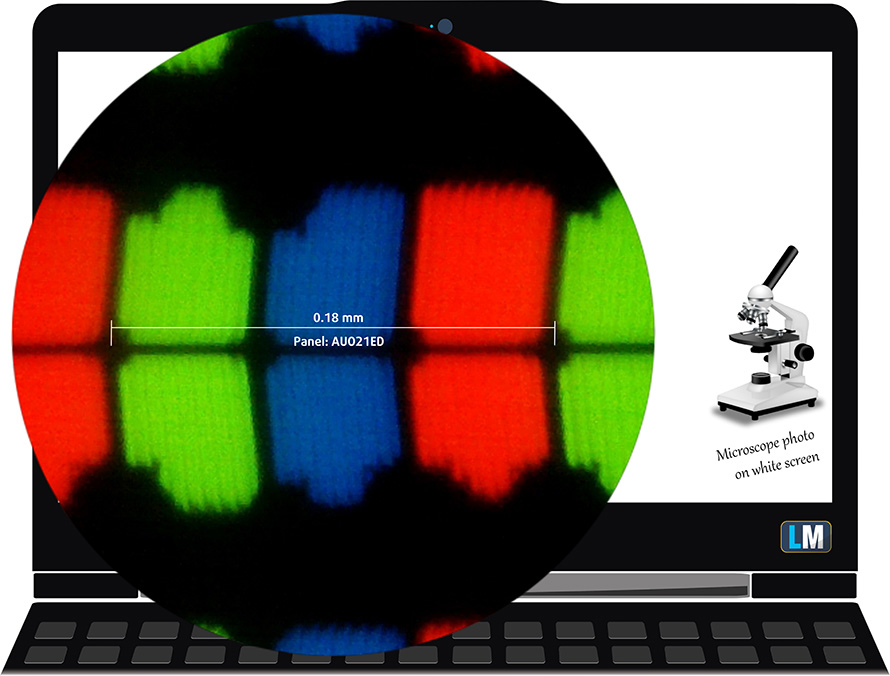
Viewing angles are good. We offer images at different angles to evaluate the quality.

The maximum measured brightness is 261 nits (cd/m2) in the middle of the screen and 252 nits (cd/m2) average across the surface with a maximum deviation of 7%. The Correlated Color Temperature on a white screen and at maximum brightness is 6380K (average) – slightly warmer than the 6500K optimum for sRGB. The average color temperature through the grey scale before profiling is 6240K.
In the illustration below you can see how the display performs from uniformity perspective. The illustration below shows how matters are for operational brightness levels (approximately 140 nits) – in this particular case at 76% Brightness (White level = 142 cd/m2, Black level = 0.1 cd/m2).
Values of dE2000 over 4.0 should not occur, and this parameter is one of the first you should check if you intend to use the laptop for color-sensitive work (a maximum tolerance of 2.0 ). The contrast ratio is very good – 1400:1.
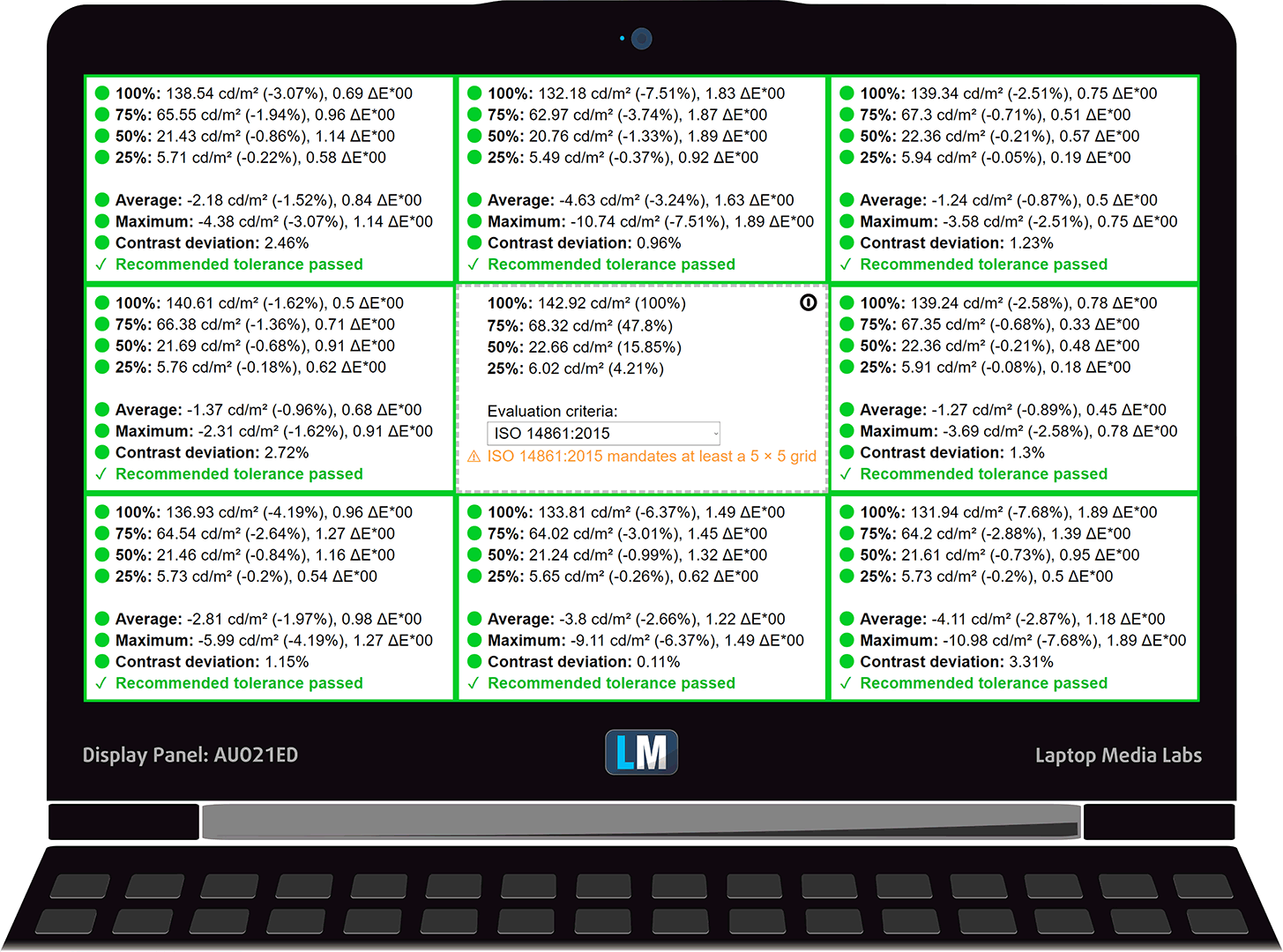
To make sure we are on the same page, we would like to give you a little introduction to the sRGB color gamut and the Adobe RGB. To start, there’s the CIE 1976 Uniform Chromaticity Diagram that represents the visible specter of colors by the human eye, giving you a better perception of the color gamut coverage and the color accuracy.
Inside the black triangle, you will see the standard color gamut (sRGB) that is being used by millions of people in HDTV and on the web. As for the Adobe RGB, this is used in professional cameras, monitors, etc for printing. Basically, colors inside the black triangle are used by everyone and this is the essential part of the color quality and color accuracy of a mainstream notebook.
Still, we’ve included other color spaces like the famous DCI-P3 standard used by movie studios, as well as the digital UHD Rec.2020 standard. Rec.2020, however, is still a thing of the future and it’s difficult for today’s displays to cover that well. We’ve also included the so-called Michael Pointer gamut, or Pointer’s gamut, which represents the colors that naturally occur around us every day.
The yellow dotted line shows HP EliteBook 850 G6’s color gamut coverage.
Its display covers 52% of the sRGB/ITU-R BT.709 (web/HDTV standard) in CIE1976.
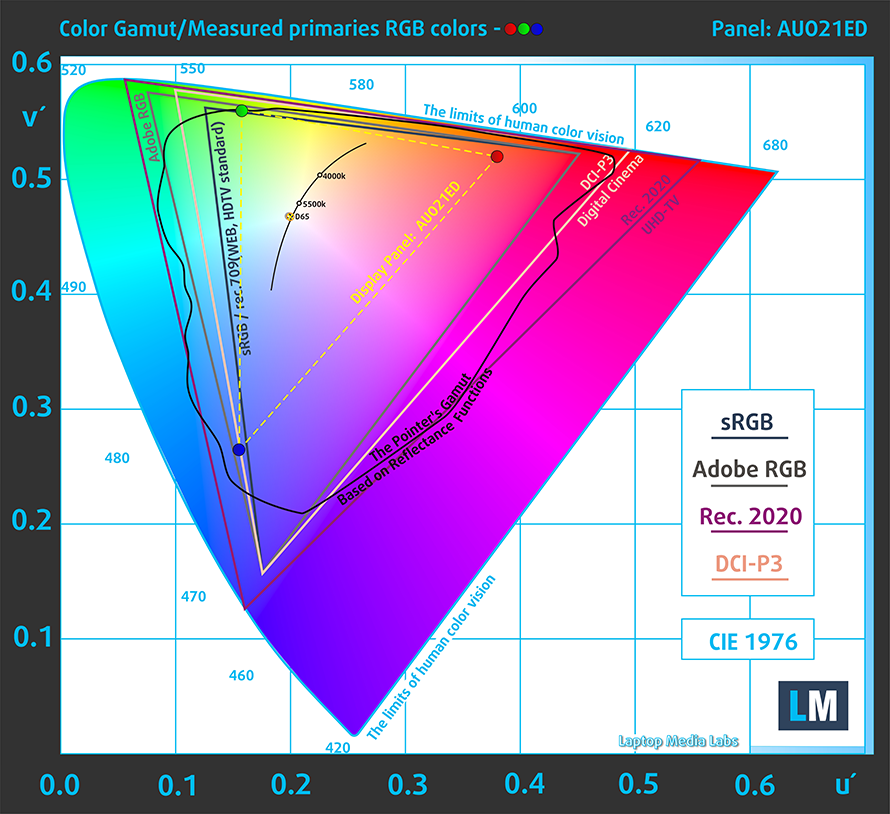
Our “Design and Gaming” profile delivers optimal color temperature (6500K) at 140 cd/m2 luminance and sRGB gamma mode.
We tested the accuracy of the display with 24 commonly used colors like light and dark human skin, blue sky, green grass, orange, etc. You can check out the results at factory condition and also, with the “Design and Gaming” profile.
Below you can compare the scores of HP EliteBook 850 G6 with the default settings (left), and with the “Gaming and Web design” profile (right).
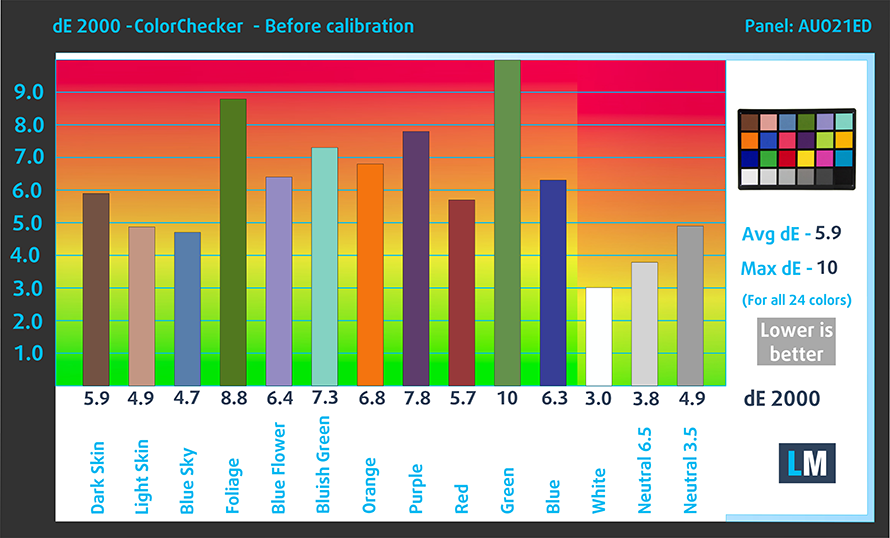
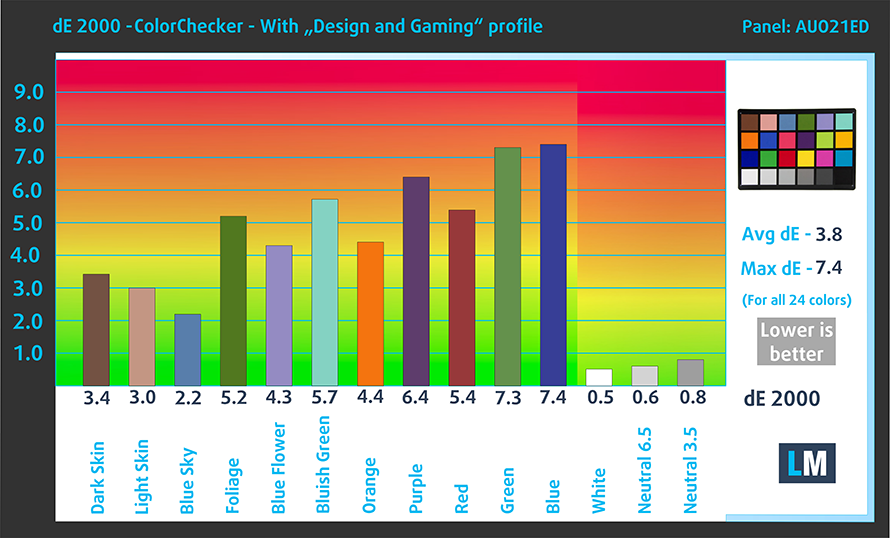
The next figure shows how well the display is able to reproduce really dark parts of an image, which is essential when watching movies or playing games in low ambient light.
The left side of the image represents the display with stock settings, while the right one is with the “Gaming and Web Design” profile activated. On the horizontal axis, you will find the grayscale and on the vertical axis – the luminance of the display. On the two graphs below you can easily check for yourself how your display handles the darkest nuances but keep in mind that this also depends on the settings of your current display, the calibration, the viewing angle, and the surrounding light conditions.
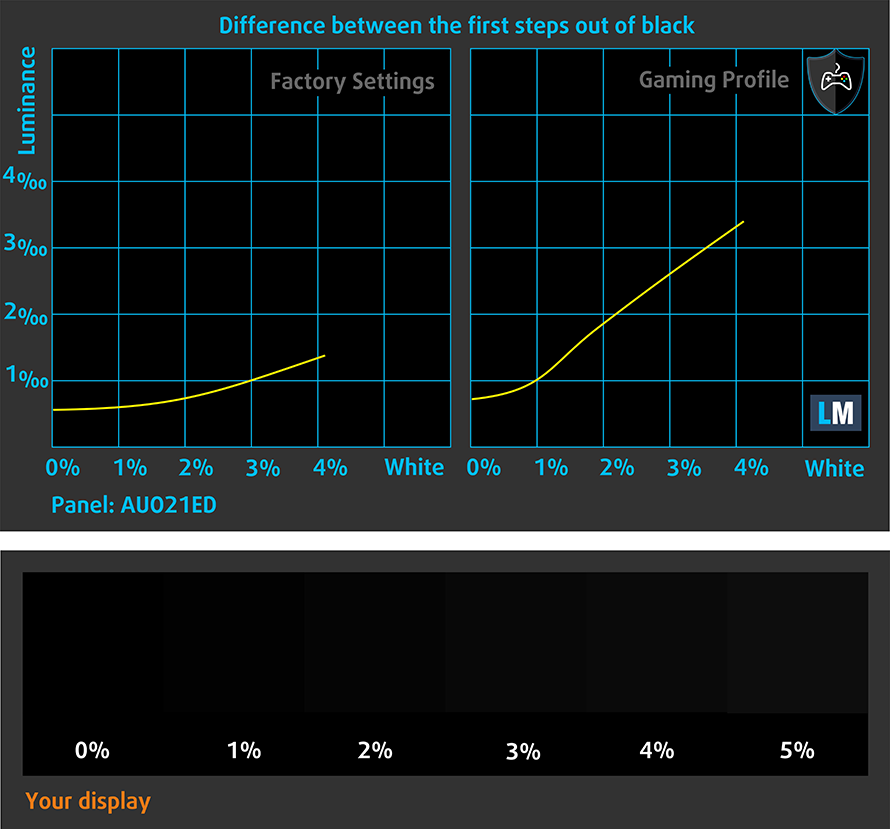
Response time (Gaming capabilities)
We test the reaction time of the pixels with the usual “black-to-white” and “white-to-black” method from 10% to 90% and vice versa.
We recorded Fall Time + Rise Time = 32 ms.
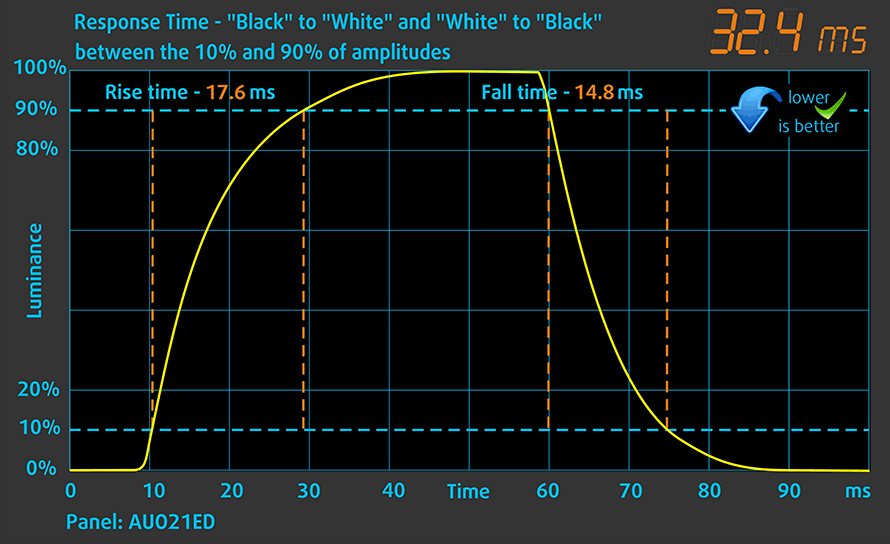
Health impact – PWM / Blue Light
PWM (Screen flickering)
Pulse-width modulation (PWM) is an easy way to control monitor brightness. When you lower the brightness, the light intensity of the backlight is not lowered, but instead turned off and on by the electronics with a frequency indistinguishable to the human eye. In these light impulses, the light/no-light time ratio varies, while brightness remains unchanged, which is harmful to your eyes. You can read more about that in our dedicated article on PWM.
HP EliteBook 850 G6’s display doesn’t use PWM to adjust its brightness levels at any point. This makes it comfortable for long use periods, without harming your eyes in this aspect.
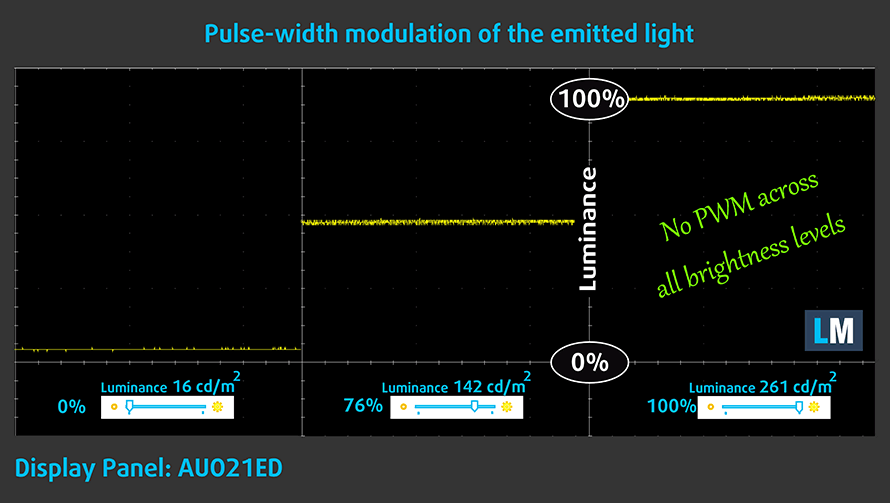
Blue light emissions
Installing our Health-Guard profile not only eliminates PWM but also reduces the harmful Blue Light emissions while keeping the colors of the screen perceptually accurate. If you’re not familiar with the Blue light, the TL;DR version is – emissions that negatively affect your eyes, skin and your whole body. You can find more information about that in our dedicated article on Blue Light.
Conclusions
HP EliteBook 850 G6’s display has an IPS panel with a Full HD resolution, comfortable viewing angles, good contrast ratio, and a non-flickering backlight. Its main disadvantage is poor color coverage.
Buy our profiles
Since our profiles are tailored for each individual display model, this article and its respective profile package are meant for HP EliteBook 850 G6 configurations with 15.6″ AUO B156HAN02.1 (AUO21ED), (FHD, 1920 × 1080) IPS.
*Should you have problems with downloading the purchased file, try using a different browser to open the link you’ll receive via e-mail. If the download target is a .php file instead of an archive, change the file extension to .zip or contact us at [email protected].
Read more about the profiles HERE.
In addition to receiving efficient and health-friendly profiles, by buying LaptopMedia's products you also support the development of our labs, where we test devices in order to produce the most objective reviews possible.

Office Work
Office Work should be used mostly by users who spend most of the time looking at pieces of text, tables or just surfing. This profile aims to deliver better distinctness and clarity by keeping a flat gamma curve (2.20), native color temperature and perceptually accurate colors.

Design and Gaming
This profile is aimed at designers who work with colors professionally, and for games and movies as well. Design and Gaming takes display panels to their limits, making them as accurate as possible in the sRGB IEC61966-2-1 standard for Web and HDTV, at white point D65.

Health-Guard
Health-Guard eliminates the harmful Pulse-Width Modulation (PWM) and reduces the negative Blue Light which affects our eyes and body. Since it’s custom tailored for every panel, it manages to keep the colors perceptually accurate. Health-Guard simulates paper so the pressure on the eyes is greatly reduced.
Get all 3 profiles with 33% discount
Sound
HP EliteBook 850 G6 has a clear sound with good quality. Low, Mid and High tones are free of deviations.
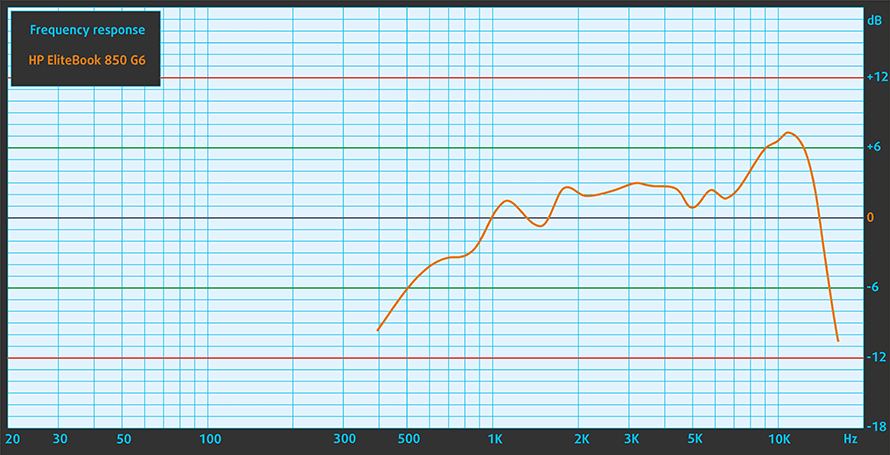
Drivers
All of the drivers and utilities for the EliteBook 850 G6 can be downloaded from here: https://support.hp.com/us-en/drivers/selfservice/hp-elitebook-850-g6-notebook-pc/26609805
Battery
Now, we conduct the battery tests with Windows Better performance setting turned on, screen brightness adjusted to 120 nits and all other programs turned off except for the one we are testing the notebook with. As we said, the laptop comes with a 56Wh package.
Apparently, the optimizations with this laptop were vastly better than last year – we got around 16 hours of Web browsing and slightly less than 14 hours of video playback.
In order to simulate real-life conditions, we used our own script for automatic web browsing through over 70 websites.

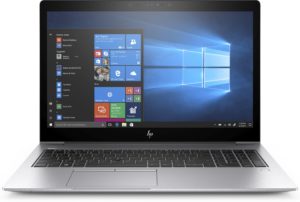

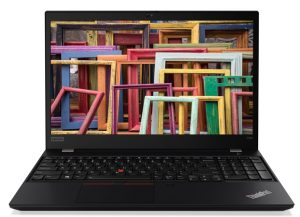
For every test like this, we use the same video in HD.




We use F1 2017’s built-in benchmark on loop in order to simulate real-life gaming.




CPU options
HP is still relying on the Whiskey Lake lineup from Intel. They include the Core i5-8265/8365U) and the Core i7-8565/8665U.
Results are from the Cinebench 20 CPU test (the higher the score, the better)
Results are from our Photoshop benchmark test (the lower the score, the better)
HP EliteBook 850 G6 CPU variants
Here you can see an approximate comparison between the CPUs that can be found in the HP EliteBook 850 G6 models on the market. This way you can decide for yourself which HP EliteBook 850 G6 model is the best bang for your buck.
Note: The chart shows the cheapest different CPU configurations so you should check what the other specifications of these laptops are by clicking on the laptop’s name / CPU.
Results are from the Cinebench 20 CPU test (the higher the score, the better)
Results are from our Photoshop benchmark test (the lower the score, the better)
GPU options
While you can get only the integrated Intel UHD Graphics 620, you can still pair it with an AMD Radeon RX 550 for that extra graphics power.
Results are from the 3DMark: Fire Strike (Graphics) benchmark (higher the score, the better)
Results are from the Unigine Superposition benchmark (higher the score, the better)
Temperatures and comfort
Max CPU load
In this test we use 100% on the CPU cores, monitoring their frequencies and chip temperature. The first column shows a computer’s reaction to a short load (2-10 seconds), the second column simulates a serious task (between 15 and 30 seconds), and the third column is a good indicator of how good the laptop is for long loads such as video rendering.

Average core frequency (base frequency + X); CPU temp.
| Intel Core i5-8265U (15W TDP) | 0:02 – 0:10 sec | 0:15 – 0:30 sec | 10:00 – 15:00 min |
|---|---|---|---|
| HP EliteBook 850 G6 | 3.41 GHz (B+113%) @ 87°C | 2.12 GHz (B+33%) @ 70°C | 2.14 GHz (B+34%) @ 71°C |
| Lenovo Ideapad L340 (15″) | 3.27 GHz (B+104%)@ 72°C | 1.99 GHz (B+24%)@ 60°C | 2.01 GHz (B+26%)@ 65°C |
| ASUS VivoBook S15 S532 | 2.96 GHz (B+85%) @ 75°C | 2.95 GHz (B+84%) @ 90°C | 2.17 GHz (B+36%) @ 68°C |
| Lenovo ThinkBook 13s | 2.76 GHz (B+73%)@ 75°C | 2.74 GHz (B+71%)@ 84°C | 2.11 GHz (B+32%)@ 74°C |
| Lenovo ThinkPad T490s | 3.43 GHz (B+114%)@ 91°C | 2.69 GHz (B+68%)@ 91°C | 2.19 GHz (B+37%)@ 80°C |
| HP ProBook 450 G6 | 2.69 GHz (B+59%)@ 64°C | 2.53 GHz (B+60%)@ 68°C | 2.09 GHz (B+31%)@ 71°C |
The laptop performs pretty well in short-term bursts, going up to 3.41 GHz. Additionally, the temperature stays in pretty good values. While at the end of the test, the clock speeds drop to 2.14 GHz, which is fine, while the temps don’t go above 71C.
Comfort during full load
More importantly, the device doesn’t heat too much on the outside, and it produces very little noise.
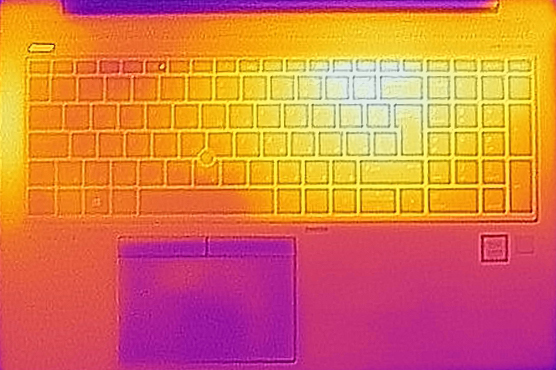

Verdict
 Instead of a regular review that we do here, today the focus was more on finding the differences between this device and its predecessor – the EliteBook 850 G5. Soon it became clear that spotting Waldo in a Bayern Munich home game would be a far easier job than explaining what is the invisible update HP did to their EliteBook 800 line up.
Instead of a regular review that we do here, today the focus was more on finding the differences between this device and its predecessor – the EliteBook 850 G5. Soon it became clear that spotting Waldo in a Bayern Munich home game would be a far easier job than explaining what is the invisible update HP did to their EliteBook 800 line up.
Most noticeable, there is a CPU change. While at first place the Kaby Lake R and the Whiskey Lake processors may seem like a mere Turbo frequency bump, the difference comes in another direction – efficiency. If you check out the CPU scores between the two generations, you are going to see a minor increase towards the newer device.
However, if you check out the battery life chart – the story becomes different. Not that the EliteBook 850 G5 had a poor battery performance – quite the opposite in fact. What makes the difference here is that the EliteBook 850 G6 offers you a tremendous time on battery power – around 16 hours of Web browsing and just beneath 14 hours of video playback (around 50% increase).
Thankfully, stuff like the rigid body structure, wide I/O expansions, Thunderbolt support, and the optional LTE connectivity have been kept unchanged. Additionally, the keyboard is very comfortable for use, as it is safe, because of its spill resistance. Moreover, you can still use the option NFC, fingerprint reader and IR face recognition system. Sadly, though, there are still no signs of an SD card reader anywhere around.
Especially for the business users – you have a Smart Card reader, for that extra step in privacy and control, as well as the docking station connector. It gives you a great improvement of versatility – plug your display, external storage and peripherals to the dock and just plug the laptop to the dock itself.
Since we got the 1080p IPS version (AUO B156HAN02.1 (AUO21ED)), we can give you information only about it. Briefly explained, this display is one of the better budget offerings out there – the default settings are good, viewing angles are comfortable, the contrast ratio is great and it doesn’t use PWM to adjust its brightness levels. On the downside, it covers only 52% of sRGB.
Honestly, we were very impressed by this machine. While it is pretty much the same device as last year, the little changes are what makes this device great. Not on the last place is also the M.2 slot that can fit either a SATA drive or a PCIe x4 NVMe drive.
As you can imagine, we would definitely recommend this notebook. However, if you would like some choice, check out the Dell Latitude 5500 or the Lenovo ThinkPad T590.
Pros
- Very comfortable to use input devices
- Backlit keyboard with spill resistance
- Great battery life
- High-level security features
- Thunderbolt support
- Optional LTE card
- Optional IR face recognition and fingerprint reader
- M.2 slot supports both SATA and PCIe x4
- Good contrast ratio and viewing angles (AUO B156HAN02.1 (AUO21ED))
- The display doesn’t use PWM to adjust brightness levels (AUO B156HAN02.1 (AUO21ED))
- Stylish and rigid body
Cons
- No SD card reader
- Only a minor refresh to its predecessor
- Covers only 52% of sRGB (AUO B156HAN02.1 (AUO21ED))
You can check the prices and configurations in our Specs System: https://laptopmedia.com/series/hp-elitebook-850-g6/
